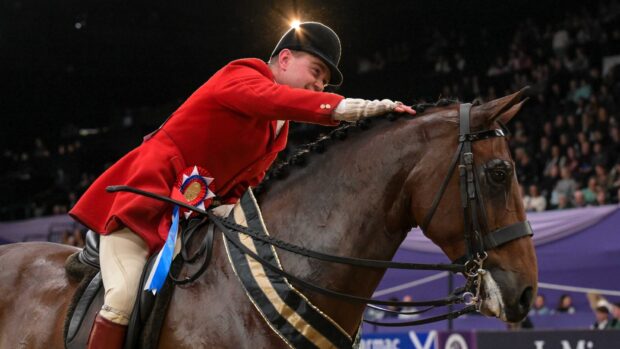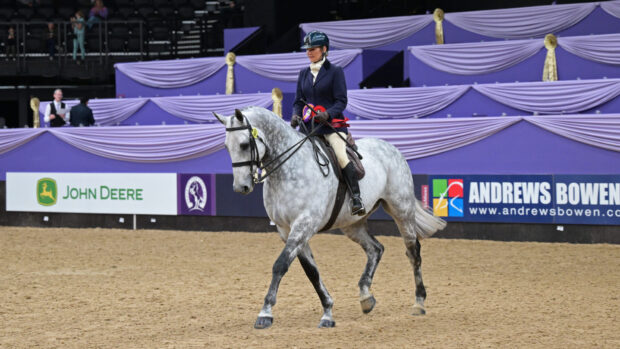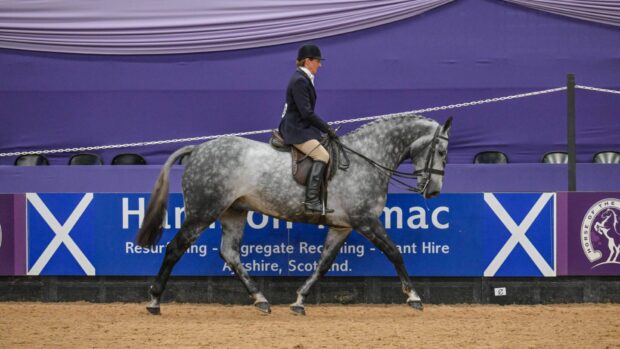If you’re looking to source your child a pony for next season, then these tips on how to buy a show hunter pony might help you.
What is a show hunter pony?
A show hunter pony should possess all the same qualities as a show hunter but in a smaller version. Many judges believe that a show hunter pony should ideally resemble a scaled down middleweight hunter in terms of type, quality, bone and substance.
The turnout of a show hunter pony is similar to that of a show hunter, too. They should be presented plaited, with their mane and tail pulled and their legs trimmed. They should wear plain leather tack with a plain browband. The rider should wear a tweed jacket.
Affiliated show hunter pony classes held under British Show Pony Society (BSPS) rules are divided into separate height sections; 122cm, 133cm, 143cm and 153cm. Each class has a rider age limit.
- Riders of 122cm ponies should not have attained their 12th birthday before 1 January in the current year.
- Riders of 133cm ponies should not have attained their 14th birthday before 1 January in the current year.
- Riders of 143cm ponies should not have attained their 17th birthday before 1 January in the current year.
- Riders of 153cm ponies should not have attained their 20th birthday before 1 January in the current year
There is also a class for intermediates of show hunter type. Animals must exceed 148cm but not exceed 158cm, and riders should not have attained their 25th birthday before 1 January in the current year.
In the lead-rein pony of hunter type and first ridden classes, ponies must not exceed 122cm.
Some shows hold mixed height hunter pony classes where all the heights will be judged together. All major shows will have classes for show hunter ponies. The biggest accolades to win are at the Royal International (RIHS) and the Horse of the Year Show (HOYS). There are also finals at HOYS and the RIHS for lead rein hunter ponies and intermediate show hunters. Some shows host hunter pony first ridden classes, but these are less common and do not have finals at the major championships.
The BSPS championships offers the largest range of classes for show hunter ponies, including specific novice and restricted sections.
What should I look for in a show hunter pony?
Vicky Stephens’s Annandale Stud has produced many champion show hunter ponies. Vicky’s mother Jennifer founded the stud and Vicky was added to the prefix 25 years ago. In 2022, both the champion and reserve HOYS show hunter pony of the year were sired by the stud’s stallion Soudley Taliesin, with the reserve being the 122cm contender Annandale Phoenix.
“Bone, substance and temperament would be the key things to look for in a hunter pony,” Vicky explains. “I like a four-square pony that is solid in stamp with enough timber. These days ponies also need to have a bit of athleticism and elevation in the movement to stand out when in the show ring.
“Today, a breeder wouldn’t necessarily breed a pony specifically for the show hunter pony role. They’re usually Welsh part-breds, Welsh ponies that plait up, or sometimes just overdone riding ponies. Ultimately, as a breeder, the most important thing is to ensure that whatever you breed has a job at the end of it.”
Karl Morris from Team Morris has produced many champion show hunter ponies.
“Initially, I would look for a pony with correct conformation,” Karl says. “Show hunter ponies are ultimately scaled down hunters, so I’d ask myself if the pony would be up to a day’s hunting, and if it would stay sound and have longevity. Type wise, I like an old-fashioned sort; it should have enough limb for its body with good-quality flat bone. It must be a good mover, too, and have a good walk.
“Temperament and brain can be hard to assess, especially if you’re buying a pony out of the field unbroken. A lot of hunter ponies have native blood in them which can make them easier to work with, in comparison to blood ponies which are a little more highly strung. Therefore assessing the breeding is a good idea.
“Even if you’re seeing a pony in the raw out in the field it’s got to give you that feeling. The good ones are getting harder to find, so the WOW factor is so important.”
What can I do with a show hunter pony?
A lot of show hunter ponies have Welsh or native blood in them, meaning they generally have level temperaments and are good doers. This makes them excellent options for families who want a pony to fit in with everyday life, and for those who want something to home-produce and do multiple jobs outside of the show ring. Of course, there are exceptions to the rule and the pony should be the right fit for the home and intended job.
Many show hunter ponies can double up as working hunter ponies if they have a jump in them, making them good, all-round choices for children.
Compared to the show pony, a show hunter pony is likely to be hardier so they can stand up to other disciplines such as hunting and Pony Club activities.
Where should I buy a show hunter pony from?
“We very rarely sell foals and will always keep ponies until they are three years old,” explains Vicky. “Foals can get lost in the system a bit, even if they’ve made a good price at the sales. They can move around and you don’t necessarily know where they will end up.
“Plus, if we keep a pony until it’s three we have a better idea of what we’re breeding. I want to know what the pairing has produced in terms of type and temperament.”
“Approach breeders if you’re hoping to buy something unbroken,” Karl says. “If you’re looking for a pony that is up and running, then ask professionals who you know or who are local to you. Most will know of ponies on the circuit.”
How much should I pay for a show hunter pony?
“We are lucky to run our ponies from a farm, and we have over a dozen mares and five to six stallions on site,” says Vicky. “This means we don’t have some of the bills that some people will have. I’m fortunate that we make our own haylage and we don’t have to pay rent, which some breeders will have to consider when selling a pony.
“We definitely get more interest if a pony has success at one of the major finals such as HOYS or the RIHS,” adds Vicky. “We love seeing them out and about doing things, but is also helps sales.”
In July 2023, Annandale New Approach won the 122cm M&M working hunter pony final at the RIHS: “Over the last year we’ve had more interest in people looking for jumping ponies,” says Vicky. “People ideally want more value from their ponies; they want a hunter pony that will also jump or have other career options. For me, as long as they have a job I don’t mind. We’ve even had ponies compete in driving, and others in polo. This comes back to keeping them until they’re slightly older; if you find that a pony has a difficult temperament, you know not to cross that mare with that stallion again.
Karl says: “It depends on your budget. I’ve bought ponies for £800 who have gone on to be superstars, but I’ve also paid more for ponies who have been there and done it.
“Don’t necessarily write off older ponies either. If you want something that is safe and that has been there and done it, there’s no reason that a 12-year-old pony couldn’t do the job at top level if it can still get those top conformation marks.”
What happens when I’ve agreed to buy a pony?
When you have agreed on a sale, it is time to organise a pre-purchase vetting, something that is strongly recommended. As the pony is for a child, perhaps asking for a trial period would be sensible, but not all sellers wish to let their animals go out on trial.
It’s important to let the vet know prior to the vetting that the pony is intended for a child to show. If you tell the vet that you want the pony for the show ring, they should hopefully inform you of any blemishes or conformational faults which could impact its future career, even if they don’t impact its soundness or performance.
As the pony is for a child, the vet will hopefully keep an eye on the temperament during the assessment, too.
“I would recommend a vetting for your own peace of mind,” Karl advises. “Even if it’s just to check the main things, like eye and heart health.”
For more information, you can read H&H’s ultimate guide to buying a horse.
You may also be interested to read…
“Turnout should be smart and workmanlike...”
H&H talks to the professionals about how to present a show hunter pony correctly...

H&H’s guide to working hunter pony classes: how to present your pony and nail your individual show

H&H’s guide to show hunter pony classes: what the judge is looking for and how to win

Subscribe to Horse & Hound magazine today – and enjoy unlimited website access all year round




